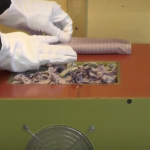How We Magnetize Magnets
Oftentimes magnets are not actually magnetic when they are in the early stages of production. In fact, magnetization is one of the last steps in the magnet-making process. Magnets that are created from rare earth elements like neodymium, are first mined, melted, milled, pressed and sintered before their magnetic energy is ever activated. During pressing the particles in the magnets are aligned, giving them a designated direction or pole. However, it is during magnetization that the magnets are given their magnetism. Until then, these demagnetized magnets can be referred to as slugs.
In order to make these slugs magnetic, we must activate their magnetic properties, which is done through a device called a magnetizer. The magnetizer is equipped with a coil wire and an electric current, which when turned on, emits an external magnetic field and activates the magnetism in the slugs.
There are two common methods of magnetization:
- Static magnetization- is generally creates smaller magnetic fields.
- Pulse magnetization- is generally used for a stronger magnetization.
- Shipping: During shipment, if a high powered magnet is active, it could potentially damage other items or interfere with navigation technology.
- Manufacturing: When building certain electronics that use a magnet, it can be difficult to assemble the pieces with an active magnet.

